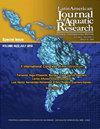Variations in the concentration of free amino acids during the early development of the Pacific red snapper Lutjanus peru
IF 0.8
4区 农林科学
Q3 FISHERIES
Latin American Journal of Aquatic Research
Pub Date : 2023-04-30
DOI:10.3856/vol51-issue2-fulltext-2980
引用次数: 0
Abstract
The free amino acids (FAAs) profile and its variations during the embryonic development and yolk-sac larvae of Pacific red snapper Lutjanus peru are described. The concentration of 15 FAAs (nine essentials and six non-essentials) was evaluated by reverse-phase high-performance liquid chromatography. The fertilized eggs of L. peru contain a small concentration of FAAs (4.77 ± 0.89 nmol ind-1). However, the variations in the FAAs pool during the early development are similar to the changes reported in other species with small pelagic eggs. The essential free amino acids are more abundant than the non-essential free amino acids throughout the studied period. During the egg stage, an increase in the FAAs was observed, and after hatching, isoleucine, leucine, lysine, and alanine were the FAAs that decreased the most during the yolk-sac larvae stage. The hatching rate was correlated with the total FAAs, the fraction of essential free amino acids, and the concentrations of glutamic acid, threonine, and valine in the egg stage, suggesting a possible role as a determinant in egg quality. Further studies are required to assess the role of FAAs in other aspects of egg development, like fertilization rate and egg buoyancy.秘鲁太平洋红鲷鱼早期发育过程中游离氨基酸浓度的变化
研究了秘鲁太平洋红鲷鱼胚胎发育和卵黄囊幼虫过程中游离氨基酸(FAAs)的分布及其变化。采用反相高效液相色谱法测定了15种FAAs(9种主要成分和6种非主要成分)的浓度。秘鲁扁豆受精卵中FAAs含量较低(4.77±0.89 nmol / 1)。然而,FAAs池在早期发育期间的变化与其他具有小型远洋卵的物种的变化相似。在整个研究期间,必需游离氨基酸比非必需游离氨基酸更丰富。卵期FAAs呈上升趋势,孵化后,异亮氨酸、亮氨酸、赖氨酸和丙氨酸是黄囊幼虫期FAAs下降最多的。孵化率与卵期总FAAs、必需游离氨基酸含量、谷氨酸、苏氨酸和缬氨酸浓度相关,提示其可能是蛋品质的决定因素。需要进一步的研究来评估FAAs在卵子发育的其他方面的作用,如受精率和卵子浮力。
本文章由计算机程序翻译,如有差异,请以英文原文为准。
求助全文
约1分钟内获得全文
求助全文
来源期刊

Latin American Journal of Aquatic Research
FISHERIES-MARINE & FRESHWATER BIOLOGY
CiteScore
1.70
自引率
10.00%
发文量
44
审稿时长
4-8 weeks
期刊介绍:
Latin American Journal of Aquatic Research- LAJAR is the continuation of the journal Investigaciones Marinas (1970-2007) and is published since 2008 by the Escuela de Ciencias del Mar, Facultad de Ciencias del Mar y Geografía of the Pontificia Universidad Católica de Valparaíso. LAJAR is an “Open Access” journal that publishes in English language, original research articles, reviews and short communications on aquatic science, which contain the results of research conducted in aquaculture or in oceanic and coastal marine waters of Latin America.
The following topics are considered: Physical Oceanography, Chemical Oceanography, Marine Biogeochemistry, Marine Pollution and Toxicology, Marine Geology and Geophysics, Biological Oceanography, Fisheries and Aquaculture.
 求助内容:
求助内容: 应助结果提醒方式:
应助结果提醒方式:


